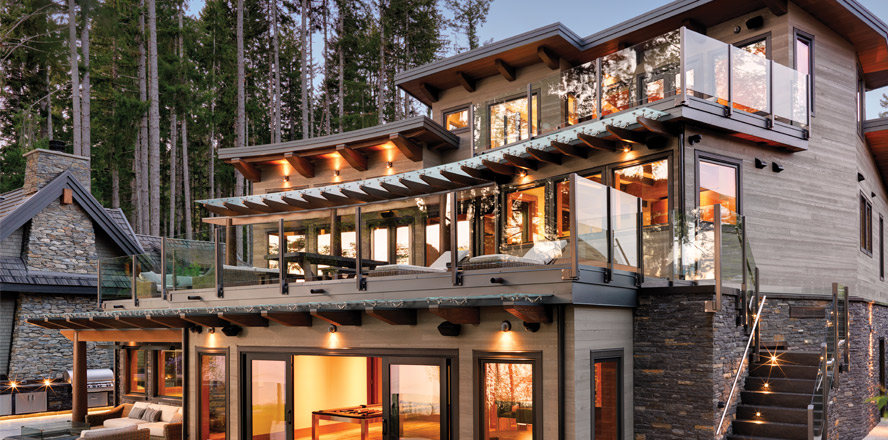– article by Barry Mathias; photos by Vince Klassen –
If, like me, you live in a traditional house built before 2010, then you are likely to have only a limited grasp of what a “Smart Home” is. You may have an electrically operated garage door, double glazed windows, a motion sensor light
on the front drive and a smart phone, but that is merely scratching the surface of the possibilities of the modern “Smart Home.”
A smart home is defined as a home that provides energy efficiency, security, comfort and convenience, whether the owners are present or not. A smart phone or a computer can control such a house, where all the devices “talk” to each other. If you live in a home like this you take it for granted, but if, like most of us, you live in a more traditional abode, then you will be amazed by what is possible.
Jason Powell, of Jason Powell Construction, was the main contractor for a remarkable home near Duncan. The Hawk’s Nest, completed last year, incorporates a wealth of smart features. “It’s important to build a house facing in the right direction, and to have an efficient heating system,” says Jason. These two prerequisites are foremost in the early planning stages, when heating and cooling a house are major considerations in the design.
Hawk’s Nest has 4,621 square feet of livable space, not including the garages and outside terraces. There is an indoor/outdoor security system allowing the owners to see all aspects of their house wherever they are in the world. The system notifies the owners of movement around the property, or changes in the interior temperature of the building, which is maintained at 68°F in every room all year round. The system can send messages to the owners using Cloud Storage technology.
“This is essentially a summer residence,” Jason says. “It has efficient windows that can alter the blinds and constantly monitor the intensity of light. There is a complex use of home automation allowing for the latest in home entertainment systems, control of lighting, and initiation of small appliances. The house can be locked or unlocked by smart phone, and takes a photograph of anyone who calls. The owners have complete control of their smart home at any time or place.”
“Our company has been nominated for four CARE Awards (Construction Achievements and Renovations of Excellence) relating to the building of Hawk’s Nest,” says Jason. The CARE Awards is the premier event for the residential construction industry managed by the Victoria Residential Builders Association.
Incorporating smart features in the planning of a house provides for maximum efficiency while allowing the design of an uncluttered free-flowing building. Keith Baker, of Keith Baker Design, was the inspiration behind the design of Hawk’s Nest, and has been designing homes for over 30 years.
“We design homes that are energy efficient, light filled, well integrated into their surroundings, and tending to use natural materials,” he says. “I believe home design should strive for authenticity. For me, that means creating a home that both fits the site and provides a vibrant, light-filled and harmonious place to live.”
Keith Baker gives an insightful reference to his design approach: “Often people get caught up in where the walls should go; I focus on where the space should be.”
He incorporates green architecture in his buildings, which seeks to decrease their environmental impact, and uses
Biophilic Design, which is an innovative way of designing the places in which we live, work and learn. This approach seeks to reconnect us to the natural world, as the poet R.S.Thomas writes: “We have lost the lust and thrust of the seedling rain.”
So, to sum up: a smart home is not simply one that contains a range of smart technology, but is designed with an emphasis on space, light and beauty. It is a building that is in harmony with its environment, and is economic to run.
As I explained at the start, the core of a smart home is the heating/cooling system. This is cutting-edge technology, and I had Dave Young, a Director at West Bay Mechanical to explain it to me. “In the Hawk’s Nest we used an outdoor Daikin air-to-water heat pump,” Dave says. “This transfers heat from the air to a refrigerant, and then into water, which is piped through oxygen barrier pipes encased in concrete to heat the home from the floor up.” He explains: “There is an insulated foam foundation. The forms are made out of foam and have concrete on all sides. Builders use the Pacific Builders Smart Wall System, which guarantees a 100% vapour barrier using high-density foam.”
In such a house, there is a purpose-built mechanical room, which houses the energy efficient High Velocity system. From here the High Velocity air handlers force air through a mini-duct distribution throughout the house. These systems can be used to provide heating, cooling, filtration, and ventilation. “Our tradesmen are like artists when it comes to designing the layout for a mechanical room,” he says proudly.
There is no doubt that if you can afford to build an energy-efficient house, you will be getting the very best in comfort, security and enjoyment, and will make huge cost savings on energy over the years. You may wonder: “what about the rest of us who have already committed ourselves to a less ambitious home?” Well, the good news is that many of these smart features can be incorporated into your home.
For instance, a High Velocity System is relatively easy to install inside existing walls and can be done with minimum remodeling. The flexible mini-ducts fit inside typically framed walls without having to cause major disturbance to the drywall.
“We can retrofit your house, whether you need extreme renovations, whether you live in a heritage house or a concrete condo,” says David Moss, owner of Patriot Electric. David is a certified Alliance contractor, and is able to set you up with BC Hydro Power Smart incentive and rebate programs, enabling you to cut your energy bills.
He refers to a typical large house with traditional heating: “The house was 20 years old, with huge heating bills that caused the owners to live like hermits in small portions of their home. By installing a heat pump and a split-duct system, the owners now have control over multiple zones, and have drastically reduced their Hydro costs.” With a smart phone, the house temperature can be altered from any location. “We have the experience and the technological knowledge and can provide you with a customized electrical design and layout, and do the full installation.”
Patriot Electric can help you design the most effective security system for your house. “We can provide the full range of CCTV equipment, and can install and service them.” You can arrange to have a crib-mounted camera that allows you to view and to speak to your baby from any location, or arrange for a lullaby to play.
“These smart features are all coming down in price by the day,” David says enthusiastically. “They are becoming more elaborate and more user-friendly.” There is no doubt that Smart House features will soon be in the reach of most homeowners.




